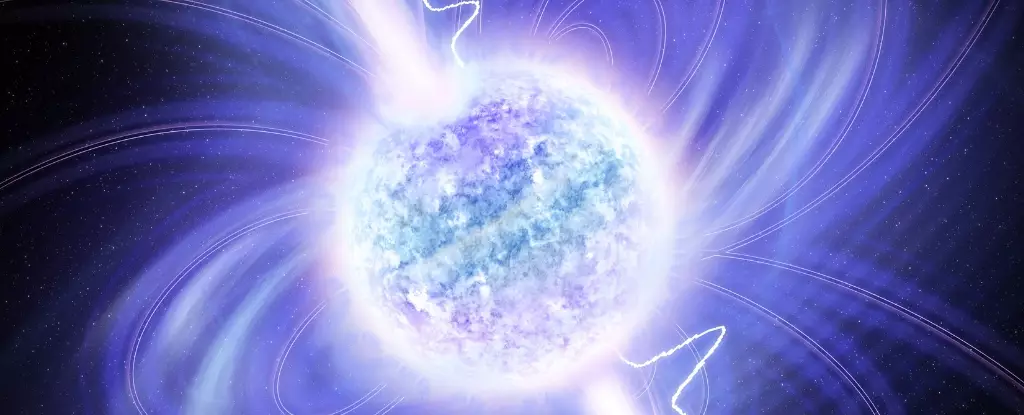In the vast expanse of the universe, where the rules of physics stretch and bend, astronomers continue to encounter phenomena that challenge existing paradigms. One such phenomenon is the recently discovered ASKAP J1839-0756, a pulsar that defies the conventional understanding of these celestial objects. This slow-spinning pulsar, which completes a rotation every 6.5 hours, is forcing scientists to reconsider what they thought they knew about neutron stars and the mechanisms behind their radio emissions.
Pulsars, with their rapidly spinning cores, have long been characterized as cosmic lighthouses, emitting beams of radio waves that sweep across space, allowing us to detect them from Earth. Typically, these stars can spin at incredible speeds, completing a rotation in mere seconds. They emit regular pulses of radiation as their magnetic and rotational axes align in such a way that we receive a signal. These rapid rotations and predictable emissions have made pulsars invaluable tools for astrophysical research, helping to probe the extreme states of matter and test the limits of physics as we know them.
However, the emergence of ASKAP J1839-0756 has introduced a new layer of complexity to our understanding. Discovered using CSIRO’s ASKAP radio telescope in Australia, this object boasts an astonishingly slow rotation rate in comparison with its faster counterparts. Initially discovered during a routine observation, the pulsar’s product — a fading burst that diminished by 95% within a quarter of an hour — hinted at something unusual. Subsequent observations across multiple advanced telescopes confirmed the periodic nature of this cosmic body, revealing a new kind of periodic radio emission that wasn’t previously imagined to exist.
What makes ASKAP J1839-0756 particularly enigmatic is its existence as a pulsar given its slow rotation speed, which contradicts existing models concerning neutron star behavior. Traditionally, once the spin of a neutron star slows beyond a certain threshold — typically around one rotation per minute — it was believed that these stars would cease to emit detectable radiation entirely. Yet, ASKAP J1839-0756 operates contrary to this paradigm, emerging at a leisurely pace of one rotation every 6.5 hours while still maintaining observable radio pulses.
This discovery has provoked questions regarding the nature of the mechanisms at play. Is ASKAP J1839-0756 truly a neutron star, or could it be something entirely different? One hypothesis posits that this object may be classified as a magnetar, a type of neutron star characterized by an exceptionally strong magnetic field. This intense magnetic environment could potentially allow ASKAP J1839-0756 to produce radio emissions through mechanisms that differ from those of typical pulsars, enabling it to shine brighter even at such a slow rotation.
Another striking aspect of ASKAP J1839-0756 is its potential to emit what are known as interpulses — secondary pulses that occur at intervals between the main emissions. In pulsars, these interpulses provide critical insights into the star’s geometry and magnetic properties, shedding light on fundamental questions about the relationship between the rotational and magnetic axes. The discovery of these interpulses in ASKAP J1839-0756 suggests that we may be observing emissions from both of its magnetic poles, which is astonishing and suggests a uniqueness not previously encountered in slower pulsars.
The existence of these weaker secondary pulses raises intriguing questions about why this particular pulsar has managed to maintain its radio emissions while spinning so slowly. It may provide insights into the geometry of magnetic fields around neutron stars and how these shapes evolve as pulsars age and their rotational speeds change.
As astronomers continue to investigate ASKAP J1839-0756, the implications for astrophysics extend beyond this particular discovery. It urges scholars to challenge their existing models and push the boundaries of our understanding of neutron stars and similar objects. The potential reclassification of ASKAP J1839-0756 — whether as a unique pulsar or a magnetar — may widen the scope for what we consider as neutron star behavior and, ultimately, the physical processes that govern the universe.
As scientists meticulously gather data across various wavelengths, the universe gradually reveals its secrets. Astronomical discoveries such as ASKAP J1839-0756 remind us of the inherent mystery of the cosmos, beckoning us to explore uncharted territories and recalibrate our cosmic compasses. Each finding encourages humility in the face of the universe’s complexity and an appreciation for the continuous quest for knowledge. As researchers keep their eyes trained on ASKAP J1839-0756, we can only anticipate the marvels that await discovery.

